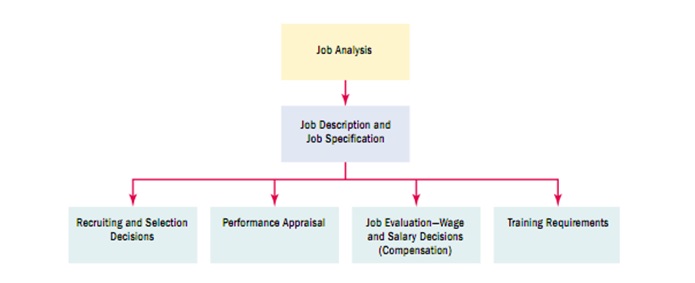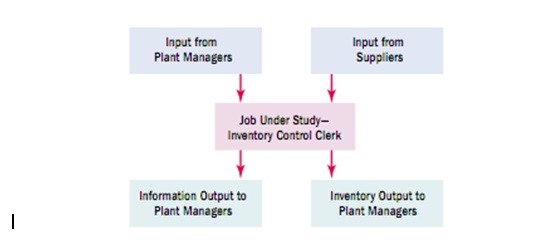Job Analysis
Globalization has changed the organizational setting and it greatly affects the work and jobs in organization. The job design efforts to generate jobs that correctly make parallel with the organizational work. Job analysis is performed on the basis of activities of people during job. These data are helpful to create job explanations and job qualifications. The main task of human resource management in job analysis is to gather data in an organized way and review bulk of information and human requirement of jobs. Job analysis is defined as "a process of studying and collecting information relating to operations and responsibilities of a specific job" (Giri, 2008, p.69). To put it simply, as the name implies job analysis is establishing requirements associated with a job. Job analysis is essential because it endorses that human resource activities are significant because the legal defensibility of an employer's recruiting and selection procedures, performance appraisal systems, employee corrective action and pay practices on the groundwork of job analysis. In job analysis, the information is compiled into job descriptions and job specifications for use in nearly all human resource activities. Accurate details of job requirements are required to authenticate human resource actions. All activities of human resource management such as HR planning, employment and selection must be based on job requirement and the capability of candidates. Job analysis has huge importance to recognize job factors and duties that maybe valuable for workplace health and safety issue. Numerous ways and data sources are used to carry out job analysis. Observation, interview, questionnaire are the common methods of collecting job analysis information. A complete assessment of job can be demanding or troublesome experience for both managers and employees because job analysis can identify the difference between current and future job (Mathis, 2007).
The Nature of Job Analysis
Job analysis is the process of determining the duties of management positions and the characteristics of the people to employ for them. Job analysis provides appropriate information that is useful for writing job descriptions and job specifications such as what kind of people to hire for the job.
The manager or human resource specialist usually collects different types of information via the job analysis.
Initially, human resource professionals collect information about the job's real work activities, such as cleaning, selling, teaching, or painting. This list may also include how, why, and when the worker performs each activity.
Human behaviors: Human resource specialist may also gather information about human behaviors such as sensing, communicating, deciding, and writing. Also information regarding job demands such as lifting weights or walking long distances is also collected for job analysis.
Another type of information needed for job analysis is Machines, tools, equipment, and work aids. This kind of information includes data regarding tools used, materials processed, knowledge dealt with or applied such as finance or law, and services rendered for example counseling or repairing.
The company may also require information about the job's performance standards in terms of quantity or quality levels for each job duty. Management will use these standards to assess employees.
Information about Job context include physical working conditions, work schedule, and the organizational and social context such as the number of people with whom the employee would usually work together and information regarding incentives.
Lastly, information about human requirements is essential for job analysis. This includes information regarding the job's human requirements, such as job-related knowledge or skills, for example, education, training, work experience and required personal attributes such as aptitudes, physical characteristics, personality, and interests.
Uses of Job Analysis
Job analysis information is highly needed to perform numerous interrelated human resource management activities. Job analysis gives thorough information about types of the job and different human characteristics required to do such activities. Such valuable information in the form of job descriptions and specifications, assists management to decide which type of candidates are useful for organization and accordingly they recruit suitable applicant. Job analysis information is vital for estimating the value of each job and its suitable compensation. Compensation such as salary and bonus generally depends on the job's necessary skill and education level, safety hazards, degree of responsibility. All factors can be evaluated through job analysis. Additionally, many employers group various jobs into classes. A performance assessment compares each employee's actual performance with his or her performance standards. Managers utilize job analysis to establish the job's specific actions and performance standards. The job description should demonstrate the activities and skills and therefore the training sessions are decided for particular job. Job analysis can also assist in unassigned duties. Job analysis is also important in EEO observance. U.S. Federal Agencies' Uniform Guidelines on Employee Selection specify that job analysis is a decisive step to authenticate all major personnel activities.
Uses of job analysis
Steps in job analysis: There are six steps to perform a job analysis.
Step 1 is to decide the way to use the information, since this will determine the data managers have collected and how they have collected them. Some data collection techniques such as interviewing the employee and asking what the job entails are effective for writing job descriptions and selecting employees for the job. Other techniques include the position analysis questionnaire which does not provide qualitative information for job descriptions. Instead, they provide numerical ratings for each job. Such data can be used to compare jobs for compensation purposes.
Step two consists of reviewing relevant background information such as organization charts, process charts, and job descriptions. Organization charts show the organization wide division of work, how the job in question relates to other jobs, and where the job fits in the overall organization. The chart should illustrate the title of each position and, by means of interconnecting lines, who reports to whom and with whom the job incumbent communicates. A process chart gives more thorough depiction of the work flow. In its simplest form a process chart shows the flow of inputs and outputs from the job you're analyzing. Finally, the existing job description, if there is one, usually provides a starting point for building the revised job description.
In step three, there is selection of representative positions because there may be too many similar jobs to analyze. For example, it is usually needless to analyze the jobs of 200 assembly workers when a sample of 10 jobs will do.
In step four, actually analysis of the job is done through collecting data on job activities which required employee behaviors, working conditions, and human traits and abilities needed to perform the job.
Step five confirms the job analysis information with the worker performing the job and with his or her immediate supervisor. This will facilitate that the information is factually correct and complete. This evaluation can also assist to gain the employee's approval of the job analysis data and conclusions, by giving that person a chance to review and modify description of the job activities.
Step six is to develop a job description and job specification. These are two real products of the job analysis. The job description is a written statement that describes the activities and responsibilities of the job, as well as its important features, such as working conditions and safety hazards. The job specification summarizes the personal qualities, traits, skills, and background required for getting the job done. It may be in a separate document or in the same document as job description.
Process chart to evaluate job work flow

There are many ways to collect information on the duties, responsibilities, and activities of a job. Conducting the job analysis generally involves a combined effort by human resource specialist, the worker, and the worker's supervisor. The HR specialist such as human resource manager, job analyst, or consultant might examine and analyze the job and then develop a job description and specification. The supervisor and worker may fill out questionnaires listing the subordinate's activities. Interviews, questionnaires, observations, and diary/logs are the most popular methods for gathering job analysis data. They all provide rational information about what job incumbents actually do. Managers use them for developing job descriptions and job specifications.
To summarize, job analysis is a systematic and purposeful process that provides descriptive important job related information. It is often considered as main function of human resource management in recruiting personnel and forming basis of all tasks in well managed HR department. It is a formal and detailed assessment of jobs. It is a methodical analysis of the tasks, duties and responsibilities required to do a job. Job analysis usually breaks the job down into meaningful component and it works with wealth of detailed information about job.

